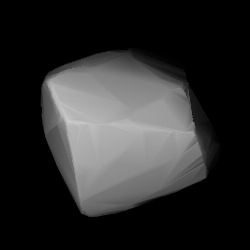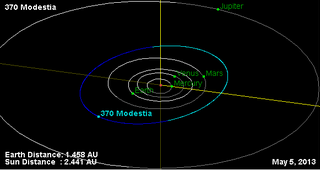
Vincentina is a fairly large main belt asteroid.

Gisela is an asteroid belonging to the Flora family in the Main Belt that has an unusually high albedo.

361 Bononia is a very large, resonant Hilda asteroid located in the outermost region of the asteroid belt. It is classified as a D-type asteroid and is probably composed of organic rich silicates, carbon and anhydrous silicates. It was discovered by Auguste Charlois on 11 March 1893, in Nice, and assigned the prov. designations A893 EF and 1893 P.

Modestia is probably a typical Main belt asteroid. It was discovered by Auguste Charlois on 14 July 1893 in Nice.

373 Melusina is a large Main belt asteroid. It is classified as a C-type asteroid and is probably composed of carbonaceous material. It was discovered by Auguste Charlois on 15 September 1893 in Nice.
Berolina is a typical Main belt asteroid.
Monachia is an asteroid orbiting within the Flora family in the Main Belt.

Rosamunde is an S-type asteroid belonging to the Flora family in the Main Belt. Its diameter is about 19 km and it has an albedo of 0.243 . Its rotation period is 9.336 hours.

Kundry is an S-type asteroid belonging to the Flora family in the Main Belt. Its rotation period is 12.605 hours.

685 Hermia is an S-type asteroid belonging to the Flora family in the Main Belt. Its diameter is about 11 km and it has an albedo of 0.281.
700 Auravictrix is an asteroid belonging to the Flora family in the Main Belt. Its diameter is about 15 km and it has an albedo of 0.246. Its rotation period is 6.075 hours.

800 Kressmannia is an S-type asteroid belonging to the Flora family in the Main Belt. Its rotation period is 4.464 hours.
823 Sisigambis is an asteroid belonging to the Flora family in the Main Belt. Its diameter is about 17 km and it has an albedo of 0.179. Its rotation period is unknown but appears to be greater than at least 12 hours. The asteroid is named after Sisygambis, the mother of Darius III of Persia.
841 Arabella is an asteroid belonging to the Flora family in the Main Belt. Its rotation period is 3.39 hours. It is named after the title character from Richard Strauss' opera Arabella.
871 Amneris is a minor planet orbiting the Sun. It is the namesake of the Amneris family, a subgroup of the Flora family of Main Belt asteroids.
883 Matterania is an S-type asteroid belonging to the Flora family in the Main Belt. Its rotation period is 5.64 hours
901 Brunsia is an S-type asteroid belonging to the Flora family in the Main Belt. Its rotation period is 3.136 hours.
905 Universitas is an S-type asteroid orbiting in the Main belt as part of the Flora family. Its diameter is about 21 km and it has an albedo of 0.085. Its rotation period is approximately 14.2 hours.

915 Cosette is an S-type asteroid belonging to the Flora family of Main Belt asteroids. Its rotation period is 4.445 hours.
935 Clivia belongs to the Flora family of Main Belt asteroids. Its diameter is about 7.9 km and it has an albedo of 0.197 .










